Basic Civil & Mechanical Engineering: UNIT III: g. Roofing
Sloping roofs or pitched roofs
Uses, Terminology, Types, Advantages, Disadvantages
Sloping Roof is having top sloping surface known as Pitched Roof. These are light in weight.
SLOPING ROOFS or PITCHED ROOFS
Sloping
Roof is having top sloping surface known as Pitched Roof. These are light in
weight.
Uses:
It is used for large spans and at places of coastal regions of heavy rain fall
and snow fall.
Terminology
1.
Span: Span is the distance between the supports of beams,
roof truss or arch.
2.
Rise: It is a vertical distance between the top of the
Ridge and Wall Plate.
3.
Pitch: It is the inclination of the sides of a roof to the
horizontal. It is the ratio of rise to span.
4.
Rafter: Rafter is an inclined wooden member running from
the ridge to eave.
5.
Wall Plate: Wall Plate is placed at the top of the
walls to support the rafter.
6.
Eave: Eave is the lower edge of the inclined roof
surface.
7.
Eave Board: It is fixed along the eave joining the
pair of rafters.
8.
Ridge: It is the apex line of a sloping roof.
9.
Ridge Piece: Ridge Piece is a horizontal member,
running along the length of the roof.
10.
Battens: Battens are small sections of the timber fixed to
the rafters for placing the roofing material on the sloping roof.
11.
Purlins: Purlins are horizontal members kept over the tie
beam to support the rafters.
12.
Truss: It is a frame work of triangles, used to carry the
load of the roof covering materials.
Types
of Sloping Roofs: 1. Single Roofs, 2. Double or Purlin
Roofs and 3. Trussed Roofs
1. SINGLE ROOFS
A
Single Roof consists of only common Rafters, supporting the roofing material.
Rafters are supported at the Wall Plates and Ridge Piece. Single roofs are used
for spans up to 5 m, so that no intermediate support is required for the
rafters.
Types
of Single Roof: (a) Lean-to Roof, (b) Coupled Roof, (c)
Coupled Close Roof and (d) Collar Beam Roof.
a)
Lean-to Roof (Fig. 3)
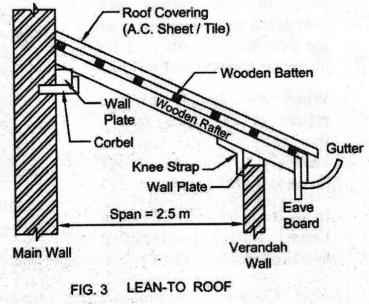
It
is the simplest type of sloping roof.
Rafters
are provided at 30° to the horizontal. These are kept at uniform intervals
along the length of the roof. These are secured on the Wall Plates at both the ends. Upper wall plate rests on Wall
Stone or Steel Corbel on the Main Wall. Battens (wooden) are fixed to the
Rafter. Roof Coverings, namely, A.C. Sheets or Tiles, are fixed to the Battens.
Uses:
It is used for verandahs, car sheds, out-houses, etc., attached to the main
buildings. This roof projects from the Main Wall of the building. Its span is
limited to 2.5 m only.
b)
Coupled Roof (Fig. 4)
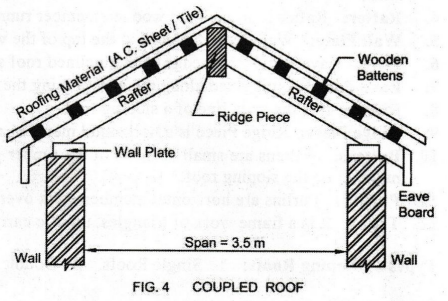
In
a Coupled Roof, a Pair or Couple of Rafters slope upwards from the Walls. The
rafters are kept at uniform intervals along the length of the roof. The rafters
are connected at the upper end to a longitudinal beam called Ridge Piece. The
ridge piece is running along the length of the roof.
The
rafters are nailed to Wall Plates at the lower ends. The wall plates are fixed
on the walls.
Roofing
Materials (A.C. Sheets or Tiles) are supported on Battens, which are fixed to the
rafters.
Use:
Coupled roof is suitable for spans up to 3.5 meters. It is not favoured, as the
rafters have a tendency to spread out at the lower ends and thrust out of the
wall.
c)
Coupled Close Roof (Fig. 5)
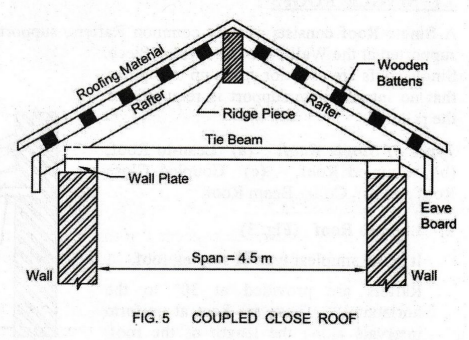
This
is similar to the coupled roof except that, the lower ends of the rafters are
connected to a Tie Beam at the bottom. There is a tie beam for each pair of
rafters.
When
the length of the rafters is becoming larger, the rafters will have a tendency
to spread out and thrust out of the walls.
It
is arrested with the Tie Beam. Such a roof is called as Coupled Close Roof.
Use:
Coupled close roof is suitable for spans up to 4.5 meters.
d)
Collar Beam Roof (Fig. 6)
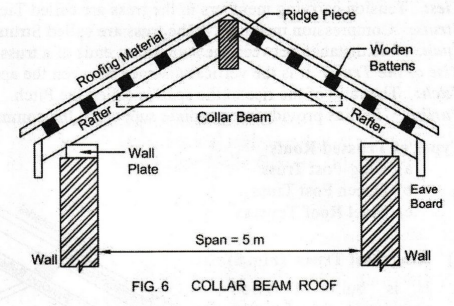
When
the span or load increases, the rafters of the coupled close roof have the
tendency to bend.
This
is avoided by raising the Tie Beam and fixing at one third to one-half of the
vertical height from the wall plate to the ridge.
This
raised beam is called Collar Beam and hence the name Collar Beam Roof.
Use:
This roof is suitable for spans of up to 5 meters.
2. DOUBLE or PURLIN ROOF
See
Fig. 7. In this type, additional supports called Purlins are provided at
intermediate points.
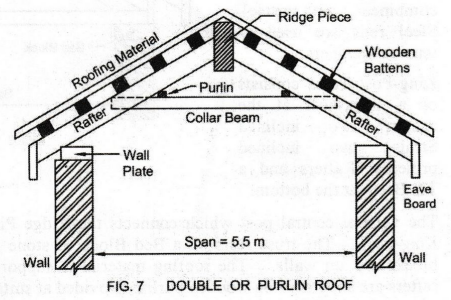
Purlins
support the Common Rafters. The size of rafters can be reduced by the use of
purlins. Purlins rest on the Collar Beam..
Each
rafter is supported at four points, namely, (i) at the bottom, on the wall,
(ii) at the top, by the ridge piece, (iii) at the center, by the collar beam
and (iv) at the intermediate supports, by purlins.
Use:
This roof is suitable for spans up to 5.5 meters.
3. TRUSSED ROOFS
A
number of straight members connected in the shape of triangle and form a frame
is known as Truss. Trusses are wooden framed structures, provided where there
are no inside walls to support the purlins.
Trusses
are provided at regular intervals of about 3 meters along the room length. The
spacing of trusses depends upon the load on the roof, position of cross walls,
span and material of the truss. Ends of purlins are supported by the trusses.
The purlins provide intermediate support to the Common Rafters, which in turn
support the Roof Covering.
Use:
Trussed Roofs are used for spans exceeding 5 meters.
Definitions
Ties:
Tension carrying members in the truss are called Ties.
Struts:
Compression members in the truss are called Struts.
Span:
The distance between the supporting ends of a truss is called its Span. Rise of
the
Truss:
It is the vertical distance between the apex and the line joining the supports.
Pitch:
The ratio of the rise to the span is called the Pitch.
Purlins:
Purlins provide intermediate support to the common rafters.
Types
of Trussed Roofs
a)
King-Post Truss
b)
Queen Post Truss
c)
Steel Roof Trusses
a)
King-Post Truss (Fig. 8)

It
is built of wood completely or of wood combined with steel. Steel rods are used
as tension members.
King-Post
Truss consists of a King-post at the center, two inclined Struts, two inclined principal
Rafters and a Tie Beam at the bottom.
The
vertical central post which connects the Ridge Piece with the Tie Beam is known
as King-post. The truss rests on a Bed Block of stone or concrete at either
end. The bed blocks rest on walls. The roofing material is supported on Common
Rafters. Common rafters are supported on wooden purlins provided at suitable
intervals.
Purlins
are supported by the Principal Rafters. The king-post connects the ridge piece
and the middle of the tie beam. The struts are connected to the king-post at
the bottom and the principal rafters at the top. Struts prevent the principal
rafters from bending at the center. The roofing material is fixed to the common
rafters.
Use:
These are used for spans in the range of 5 to 9 meters.
b)
Queen-Post Truss
Queen-Post
Truss is also a timber truss. It consists of two queen-posts instead of one as
in king-post truss. It is used for spans from 9 m to 12 m.
c)
Steel Roof Trusses
Timber
trusses become very heavy and costly, when the span exceeds 10 meters. Mild
steel is readily available in rolled sections of standard shapes and sizes,
namely, Angles, Channels, T-Sections, I-Sections, etc.
Steel
Roof Trusses are frames formed by a number of straight members, made of Steel
Angles. These members are connected in the shape of triangles. The members are
joined together by welding or riveting. External loads act at these joints of
the members.
Shape
and positioning of members in this truss are designed such that the members are
subjected to either tension or compression. The compression members are called
Struts. The compression members should be short to avoid buckling. The tension
members are known as Ties. The Angle sections resist both tension and
compression effectively.
The
Principal Rafter and the Main Ties are made of two angle sections placed side
by side. The Struts and Ties are made of single angle sections.
Advantages
of Steel Roof Trusses
1.
Rigidity: Steel trusses are more rigid and
stronger than wooden trusses.
2.
Tensile and Compressive Strength: Members of the steel
trusses are equally strong in both tension and compression.
3.
Easy to Fabricate: They are easy to fabricate from
rolled steel sections, which are readily available in the required dimensions.
4.
Economical: They are more economical compared to
timber trusses.
5.
Durability: Steel trusses are permanent structures
with durability of a very long life.
6.
Resistant to Environment: Steel trusses are more
resistant to environmental / atmospheric agencies.
7.
Fire Resistant: They are fire resistant unlike timber.
8.
Termite-Proof: They are termite-proof unlike timber.
9.
Easy Installation: They can be easily installed.
Disadvantages
of Steel Roof Trusses
Steel
Roof Trusses are likely to get rusted. They must be painted with anti-corrosive
paints. Hence, steel trusses need periodical maintenance.
Uses
(i)
Used over any span length ranging from 4.5 meters to very large spans up to 30 meters.
(ii)
Buildings of large spans such as educational institutions, industries,
auditoriums, theatres, godowns, warehouses, garages, etc., including bridges.
(iii)
No intermediate columns in the above type of buildings.
(iv)
Availability of a clear and un-obstructed working space.
(v)
Used in places of heavy rain fall or snow fall.
4. TYPES OF STEEL ROOF TRUSSES
The
type, size, and relative positions of members of a steel roof truss are based
on the Span, Roof slope, Load coming over the roof, Roof covering material and
Center-to-center of the truss.
1.
King-Post Steel Truss
See
Figs. 9(i) and (ii).
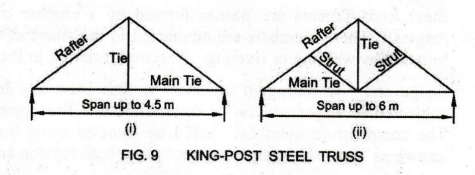
The
relative positions of the members of the truss, namely, Main Tie, Tie, Rafters
and Struts are shown.
The
steel truss shown in Fig. (i) can be used for spans up to 4.5 meters. The steel
truss shown in Fig. (ii) can be used for spans up to 6 meters.
2.
Simple Fink Steel Truss
See
Fig. 10. Fink Type Truss is found to be very satisfactory for ordinary
buildings. These trusses are used for spans up to 8 meters.
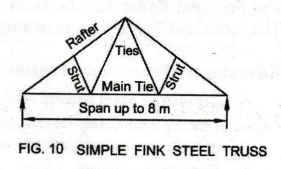
3.
Simple Howe's Steel Truss
See
Fig. 11. These trusses are used for spans up to 12 meters.
 4.
Compound Fink Steel Truss or French Truss
4.
Compound Fink Steel Truss or French Truss
See
Fig. 12. This type is also known as French Truss. These trusses are used for
spans up to 15 meters.
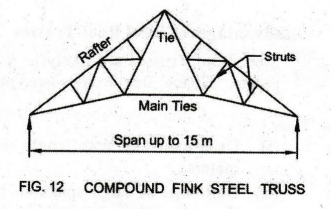
5.
Compound Howe's Steel Truss
See
Fig. 13. In this truss, the diagonals are in compression and the verticals are
in tension under dead load. These trusses are also used for spans up to 15 meters.
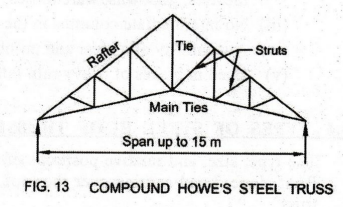
6.
North Light Steel Truss
See
Fig. 14. These trusses are used for spans up to 15 meters. This type of truss
is used for industrial buildings to obtain adequate natural lighting for a wide
building
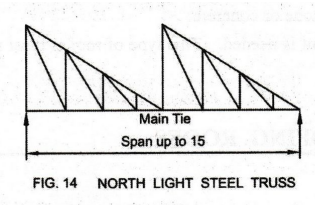
In this, the steep sides of the truss are glazed. The glazed panel is faced towards North to avoid direct sunlight and direct glaring of the sun. This type of truss is also known as Saw Tooth.
7.
Bow String Steel Truss
See
Fig. 15. These trusses are used for spans up to 30 meters.
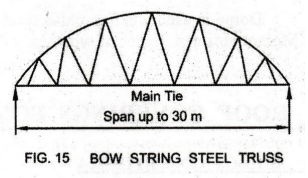
Basic Civil & Mechanical Engineering: UNIT III: g. Roofing : Tag: : Uses, Terminology, Types, Advantages, Disadvantages - Sloping roofs or pitched roofs
Related Topics
Related Subjects
Basic Civil and Mechanical Engineering
BE3255 2nd Semester 2021 Regulation | 2nd Semester EEE Dept 2021 Regulation
